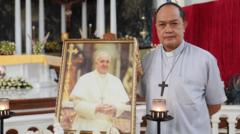As the papal conclave commences in the Sistine Chapel, cardinals face the challenge of electing a new pope who can steer the Catholic Church through turbulent waters marked by past scandals and ideological divides.
Pope Conclave Commences Amid Prominent Challenges for the Catholic Church

Pope Conclave Commences Amid Prominent Challenges for the Catholic Church
133 cardinals gather in the Vatican to begin the process of electing a new pope, marking a pivotal moment for the Roman Catholic Church grappling with contemporary issues.
In a significant ceremonial gathering, the conclave to select the next leader of 1.4 billion Roman Catholics began with the entry of 133 cardinals into the Sistine Chapel on May 7, 2025, following the death of Pope Francis. The historic context of this gathering is underscored by the turbulent atmosphere surrounding the Church as it grapples with issues such as financial strain and the fallout from sex abuse scandals. With the largest number of voting cardinals ever assembled, this conclave unfolds at a crucial juncture for the Church.
Before entering the chapel for the first round of voting, the cardinals attended a Mass at St. Peter’s Basilica, marking their last public engagement before being sequestered. The voting process is veiled in secrecy, requiring the cardinals to take an oath to uphold strict confidentiality, and they will endure a series of votes until a candidate secures a two-thirds majority. Speculations about potential successors range from Cardinal Pietro Parolin, Pope Francis’ former deputy, to Cardinal Luis Antonio Tagle, noted for his popularity in the growing Catholic community in the Philippines.
The election symbolizes not just the transition in leadership but also a referendum on the ideological future of the Church, as the influence of conservative and progressive factions is prevalent. This conclave differs notably from preceding ones due to many cardinals being new to each other, potentially complicating alliances and agreements. The previous pontificate under Francis was marked by openness and inclusion, setting a high bar for whoever emerges as his successor.
As the cardinals embark on this pivotal journey within the hallowed halls of the Sistine Chapel, with its breathtaking frescoes by Michelangelo serving as both a backdrop and a reminder of their sacred duty, the outcome remains uncertain. The next days will be critical in resolving not just the identity of the new pope but also the future direction of the Catholic Church as it navigates through these stormy waters.
Before entering the chapel for the first round of voting, the cardinals attended a Mass at St. Peter’s Basilica, marking their last public engagement before being sequestered. The voting process is veiled in secrecy, requiring the cardinals to take an oath to uphold strict confidentiality, and they will endure a series of votes until a candidate secures a two-thirds majority. Speculations about potential successors range from Cardinal Pietro Parolin, Pope Francis’ former deputy, to Cardinal Luis Antonio Tagle, noted for his popularity in the growing Catholic community in the Philippines.
The election symbolizes not just the transition in leadership but also a referendum on the ideological future of the Church, as the influence of conservative and progressive factions is prevalent. This conclave differs notably from preceding ones due to many cardinals being new to each other, potentially complicating alliances and agreements. The previous pontificate under Francis was marked by openness and inclusion, setting a high bar for whoever emerges as his successor.
As the cardinals embark on this pivotal journey within the hallowed halls of the Sistine Chapel, with its breathtaking frescoes by Michelangelo serving as both a backdrop and a reminder of their sacred duty, the outcome remains uncertain. The next days will be critical in resolving not just the identity of the new pope but also the future direction of the Catholic Church as it navigates through these stormy waters.





















